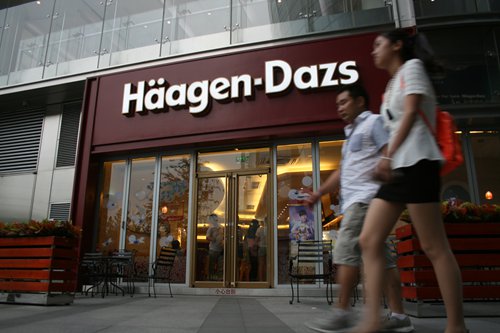
A Haagen-Dazs store in Jinan, capital of East China's Shandong Province .(File Photo: VCG)
From Haagen-Dazs to Bassetts to other niche brands, US ice cream makers have expanded all over the Chinese market in recent years. But now many of them are worried that the ongoing trade dispute between China and the US will make their business difficult in China.
Bassetts is a Philadelphia-based ice cream producer, and in May 2008, it shipped its first order to China. Over the past 10 years, Bassetts opened four ice cream shops in three Chinese cities. But now the company is worried that the trade dispute between China and the US might hamper its business prospects in China.
"We are concerned that the recent tariff increase may have a negative effect on our sales (in China), but we have not shipped an order since the increase so we do not know yet what the effect will be. We are certainly hoping that the 'trade war' is resolved quickly, and that the increase in the tariff will be reversed," Michael Strange, president of Bassetts Ice Cream Co, told the Global Times on Wednesday.
On August 3, China announced plans to impose 25 percent import tariffs on ice cream and other ice products from the US, as part of a list of $60 billion in tariff increases on US products.
Prior to that, the US had announced it would increase tariffs on $200 billion of Chinese imports.
Ohio-based ice cream brand Pierre's was brought into China in 2015 via Bulubaier Enterprise Management (Dalian) Corp. Christina Lin, manager of the international trade department at Bulubaier, said that the effect of the tariff increase has not shown up yet in the company's business.
But she stressed that the increased tariff, on top of an existing 28 percent import tariff, would cut the company's profits. "We don't want the trade dispute to evolve. We want tariffs to be lower, not higher," she told the Global Times Wednesday.
For US ice cream brands, the arrival of the trade dispute is a pity as their exploration of the Chinese market has been relatively successful in recent years. Haagen-Dazs, for example, has its shops scattered around first-tier cities and is becoming a widely known brand among Chinese consumers.
Pierre's is also doing well. It has opened 48 shops in 10 provinces in China. Sales have been rising since the brand entered China, and retail revenues of Pierres ice cream reached about 30 million yuan ($4.35 million) by the end of 2017, Lin disclosed.
Strange also said that 2017 "was an excellent year" for sales.
"We are hopeful that 2018 will be even better, but much will depend on the impact of the recently increased tariffs," he said.
"The overall ice cream market is on the rise in China, with people eating ice cream in all seasons, and the age range of ice cream consumers is also widening," said Zhu Danpeng, a food industry analyst based in Guangzhou, capital of South China's Guangdong Province, adding that US brands would try all means to take advantage of these trends.
Su Gan, a Shanghai-based ice cream wholesaler and importer, said that his company used to import US ice cream brands like Crystal and Ben & Jerry's, but now the company is giving up most of the US-related business and turning to ice cream from countries like South Korea and New Zealand.
According to Su, he mostly fears that the trade dispute, if it worsens further, might trigger consumer boycotts of US products, which would be "a great pressure" for intermediate importers, he told the Global Times on Tuesday.
A Beijing-based consumer surnamed Huang said that she recently bought a package of Haagen-Dazs ice cream for about 75 yuan. "It's already expensive. If they increase the price further, I will give up the brand and shift to other choices," she told the Global Times.
Strange said that he still has hopes for China's market potential.
"(China's) large population, increasing incomes and demand for Western products, especially luxury items like super-premium ice cream, all suggest that there is still much opportunity for growth.
"But a lot will depend on whether the new increased tariffs remain in place, and if they do, whether Chinese consumers will be willing to pay more than they do now," he said.


